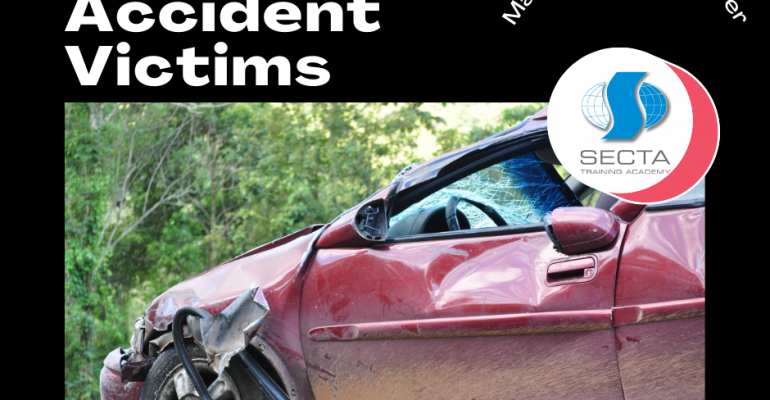First Aid – Road Accident Victims
2 September 2023 2023-09-02 2:40First Aid – Road Accident Victims
One day, you might find yourself as the first person to arrive at the scene of a road accident, or you could be involved in a collision without sustaining injuries. In such moments, would you know what to do? In Australia, thousands of lives are lost, and tens of thousands are injured due to road traffic accidents annually. While factors like road conditions, distractions, and negligent driving contribute to these accidents, a significant number of casualties could have been prevented if immediate first aid had been administered.
Based on our national road toll data, it is evident that many lives could have been saved with timely first aid, even before paramedics arrive. This underscores the critical importance of basic road safety awareness and knowledge of first aid.
Now, imagine you’re the first to arrive at a motor vehicle accident scene. Let’s explore the life-saving steps you can take to help a road accident victim.
Arriving at the Accident Scene:
Your safety is paramount. Ensure the scene is safe to enter and accessible before attempting to render first aid.
Check for Injuries:
If you are unharmed, assess your own condition first. Then, evaluate the extent of injuries in others. Look for bleeding in various body parts.
Call Ambulance Services:
Immediately dial emergency services to inform them of the incident. Seek their guidance on providing initial care and arranging transportation to the nearest medical facility.
Check for Obstructions in the Mouth or Throat:
If the victim has stopped breathing, check for airway obstructions and clear them using the appropriate technique.
Perform Life-Saving Techniques:
In cases of no pulse, unresponsiveness, and no breathing, initiate CPR promptly. Place the victim in the recovery position, maintain neck alignment, and proceed with CPR.
Treat Bleeding Wounds:
Apply continuous pressure to bleeding wounds using a clean cloth or soft pad. Press firmly to control bleeding and address fractures as needed.
Dealing with Spinal Injuries (Always Suspect Spinal Injuries):
Neck and spinal injuries are common in road accidents. If the victim is unconscious or their neck is not in a normal position, avoid moving them unless immediate danger is present. Rough handling can exacerbate neck and spinal injuries.
Keep the Victim Warm:
Victims often experience shock-induced coldness after an accident. To aid their recovery, provide warmth using available clothing or materials.
To reduce the incidence of fatal road accidents, it’s crucial to equip ourselves with the knowledge of dealing with such situations. Consider attending a first aid course to acquire basic life-saving skills that can be learned in just a few hours.
For more information and resources, visit www.secta.com.au. Let’s work together to make our roads safer and save lives through preparedness and quick action.First Aid – Road Accident Victims
One day, you might find yourself as the first person to arrive at the scene of a road accident, or you could be involved in a collision without sustaining injuries. In such moments, would you know what to do? In Australia, thousands of lives are lost, and tens of thousands are injured due to road traffic accidents annually. While factors like road conditions, distractions, and negligent driving contribute to these accidents, a significant number of casualties could have been prevented if immediate first aid had been administered.
Based on our national road toll data, it is evident that many lives could have been saved with timely first aid, even before paramedics arrive. This underscores the critical importance of basic road safety awareness and knowledge of first aid.
Now, imagine you’re the first to arrive at a motor vehicle accident scene. Let’s explore the life-saving steps you can take to help a road accident victim.
Arriving at the Accident Scene:
Your safety is paramount. Ensure the scene is safe to enter and accessible before attempting to render first aid.
Check for Injuries:
If you are unharmed, assess your own condition first. Then, evaluate the extent of injuries in others. Look for bleeding in various body parts.
Call Ambulance Services:
Immediately dial emergency services to inform them of the incident. Seek their guidance on providing initial care and arranging transportation to the nearest medical facility.
Check for Obstructions in the Mouth or Throat:
If the victim has stopped breathing, check for airway obstructions and clear them using the appropriate technique.
Perform Life-Saving Techniques:
In cases of no pulse, unresponsiveness, and no breathing, initiate CPR promptly. Place the victim in the recovery position, maintain neck alignment, and proceed with CPR.
Treat Bleeding Wounds:
Apply continuous pressure to bleeding wounds using a clean cloth or soft pad. Press firmly to control bleeding and address fractures as needed.
Dealing with Spinal Injuries (Always Suspect Spinal Injuries):
Neck and spinal injuries are common in road accidents. If the victim is unconscious or their neck is not in a normal position, avoid moving them unless immediate danger is present. Rough handling can exacerbate neck and spinal injuries.
Keep the Victim Warm:
Victims often experience shock-induced coldness after an accident. To aid their recovery, provide warmth using available clothing or materials.
To reduce the incidence of fatal road accidents, it’s crucial to equip ourselves with the knowledge of dealing with such situations. Consider attending a first aid course to acquire basic life-saving skills that can be learned in just a few hours.
For more information and resources, visit www.secta.com.au. Let’s work together to make our roads safer and save lives through preparedness and quick action.



